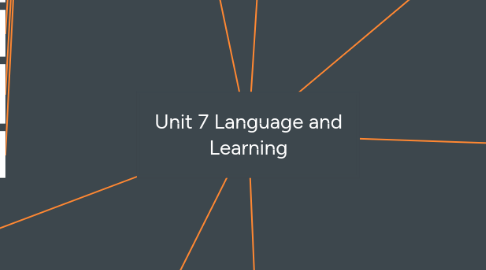
1. Language
1.1. spoken, written, signed words and the ways we combine them to communicate meaning
1.2. Phoneme: smallest distinctive sound unit
1.3. Morpheme: smallest unit that carries meaning
1.4. Grammar: system of rules that enable communication and understanding of one another
1.4.1. Syntax - ordering words into sentences
1.4.2. Semantics - set of rules for deriving meaning from sounds
1.5. Receptive language
1.5.1. 4 months old: recognize differences in speech sounds
1.5.2. 7 months old+: segment spoken sounds into individual words
1.6. Productive language
1.6.1. 4 months old: babbling stage
1.6.2. 10 months old: babbling imitates household language
1.7. Language Development
1.7.1. 10 months old
1.7.1.1. Lose ability to create and pick up on sounds not within their household language
1.7.2. 1 year old
1.7.2.1. 1 word stage
1.7.3. 2 years old
1.7.3.1. 2 word stage into telegraphic speech (car go, doggy bad) that follows language’s syntax
1.8. Usually start speaking nouns first, no matter what language we learn
1.9. Infancy and Childhood
1.9.1. Critical period for mastering certain aspects of language
1.9.2. Learn multiple languages without an accent and good grammar if exposed before puberty
1.10. Deaf culture advocates
1.10.1. Controversy over cochlear implants
1.11. Different areas of brain serve different language functions
1.12. Different neural networks activated by nouns & verbs, or objects & sounds
1.13. Processing language = information processing in our brains
1.14. Other species can form concepts, count, use tools, show compassion, have insight, care for one another, and have cultural tools
1.15. Linguistic determination: Whorf’s hypothesis that language determines the way we think
2. Basic Learning and Classical Conditioning
2.1. Through learning we adapt, expect, prepare for events, repeat acts that give us rewards, avoid acts that bring unwanted results
2.2. Habitual behaviors - repeat behaviors in a given context
2.2.1. Repeating behaviors
2.3. Classical conditioning: learning where you link two or more stimuli and anticipate events
2.4. Behaviorism
2.4.1. Psychology should be an objective science
2.4.2. Studies behavior without reference to mental processes
2.5. Ivan Pavalov's Experiment
2.5.1. Presented neutral stimulus before an unconditioned stimulus
2.5.2. Neutral stimulus became a conditioned stimulus, producing a conditioned response
3. Operant Conditioning
3.1. Law of Effect: Thorndike’s principle that rewarded behaviors will likely to recur and vice versa
3.2. Operant Chamber: Skinner Box a box with a bar/key that an animal manipulates to obtain food/water
3.3. Immediate reinforcer: immediate gratification
3.4. Delayed reinforcer: x amount of time passes before gratification
3.4.1. Studying children show the ones that can wait for delayed reinforcement grow up to be more socially competent and high-achieving adults
3.5. nimals tend to consistently respond to unpredictable schedules
3.6. Occasional and unpredictability reinforces behavior because of hope
3.7. Punishment
3.7.1. Punishment tells you what not to do, reinforcement tells you what to do
3.7.2. Punished behavior is suppressed, not forgotten
3.7.3. Punishment teaches discrimination among situations
3.7.4. Punishment can teach fear
3.7.5. Physical punishment may increase aggression by modeling aggression as a way to cope with problems
4. Concepts
4.1. Cognition: mental activities associated with thinking, knowing, remembering, and communicating
4.2. Prototypes: mental image or best example of a category
5. Problem Solving
5.1. Algorithms: methodical, logical rule or procedure that guarantees solving a particular problem
5.2. Heuristics: simple thinking strategy that help us make judgements and solve problems efficiently
5.3. Insight: sudden realization of a problem’s solution
5.4. Confirmation bias: tendency to search for information that supports our preconceptions and to ignore contradictory evidence
5.5. Mental set: tendency to approach a problem in one particular way, usually has been successful before
6. Effects of Biology and Cognition
6.1. John Garcia and Robert Koelling
6.1.1. Taste aversion: avoiding food items that made an animal sick
6.1.2. Learn behaviors favored by natural selection
6.2. Animals learn and retain behaviors that reflect our biological predispositions
6.3. Cognitive processes influence our behavior
6.3.1. Animals can predict an event and becomes more aware of such stimulus
6.3.2. Associations influence attitudes
6.3.3. Classical conditioning treatment that ignore cognitive processes have limited success
6.4. More to learning than just associating a response with a consequence
6.5. Excessive rewards can also hinder behavior
6.5.1. Intrinsic motivation: desire to perform a behavior effectively its own sake
6.5.2. Extrinsic motivation: desire to perform a behavior to receive promised rewards or avoid punishment
6.6. Studies and scans show monkeys and human babies have a strong tendency to imitate what’s being observed
6.6.1. Controversy: Is it mirror neurons? Or is it our brain network?
6.6.2. icariously experience other people’s experience
6.7. Prosocial effects
6.7.1. Businesses model desired employee behavior
6.7.2. artin Luther King Jr., Gandhi, other famous non violent civil rights activists gained thousands of supporters through modeling
6.8. Antisocial effects
6.8.1. Aggressive behavior
7. Forming Good and Bad decisions
7.1. We reason emotionally and neglect probabilities
7.2. Intuition: effortless, immediate automatic feeling/thought
7.3. Availability heuristic: estimating the likelihood of events based on availability in memory
7.4. Overconfidence: overestimate accuracy of our beliefs and judgments
7.5. Belief perseverance: clinging to one’s initial conceptions after the basis on which they were formed has been discredited
7.6. Once beliefs are formed, takes more compelling evidence to change the beliefs
7.7. Fear Factor
7.7.1. We fear what our ancestral history has prepared us to fear
7.7.2. We fear what we cannot control
7.7.3. We fear what is immediate
7.7.4. We fear what is most available in memory
